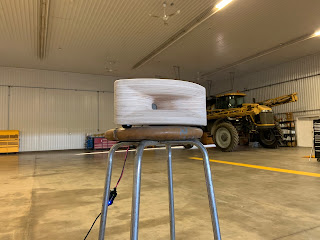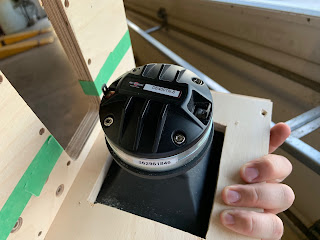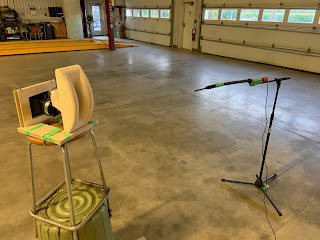The ES-800 Biradial was designed in 3D CAD which uses the special Exponential Spiral (ES) horn flare geometry in both axis. This horn geometry had proven successful in a circular horn and so I wanted to apply this special curvature to a bi-radial design to compete with the popular Yuichi designs. In this blog post I feature the horn and compare acoustical measurements against a similar size Constant Directivity horn, namely the B&C ME20. The compression driver used for the testing is a B&C DE400TN with mylar replacement diaphragms.
 |
| ES-800 Biradial with Zebra Wood layer. The throat adapter is not shown. |
 |
| 3D CAD Rendering of the ES-800 Biradial with TAD-2001 Compression Driver |
The horn is designed to load down to 800Hz and is 32cm wide x 12cm high. The throat is a 1" and will accommodate most 1" compression drivers such as the TAD-2001, B&C DE250, or the vintage Altec drivers such as the 908-8A.
 |
| Temporary crossover setup in my main listening room |
 |
| ES-800 Biradial flanking my custom 50 liter Onken Enclosures using the Fostex FW208HS woofer. |
Measurement
To get some good measurements I decided to use my father's shop which is nice and open. I wanted to get a reflection free environment to within 1.5 meters using a gated frequency response in ARTA measurement software.
I also mounted my measurement mic onto a tube so that I would not get any reflections off the mic holder. I plan on making a better stand to hold everything higher off the floor. But since my test was looking at 500Hz and above I think everything was far enough away to get reflection free measurements.
 |
| Mic shown mounted onto tube to reduce acoustic reflections off the mic holder. |
As mentioned earlier I needed something to compare against so the only horn I had on hand was the B&C ME20. This is a popular horn featuring the Constant Directivity (CD) flare which is supposed to provide even coverage without any narrowing as you move up in frequency. This is a common problem with exponential horn flares, or at least in theory. CD horns are almost exclusively used in live sound reinforcement (Pro Sound) because of the controlled coverage pattern which provides a nice even coverage across the venue (or at least it's supposed to). The ES-800 Biradial is designed specifically for 2 channel audiophile music listening, and so it is not restrained by the design requirements for live sound reinforcement. Emphasis can be placed on superior time domain measurements at the expense of a broad coverage pattern in the high frequencies. But as you will see the underlying assumptions don't always hold true and there are a few surprised up ahead!
In the following tests I will show the frequency response, step response, horizontal and vertical coloured polar maps, and burst decay (waterfall plot) measurements for both the ME20 CD Horn and the ES-800 Biradial horn.
Frequency Response
Below is the frequency response for the B&C ME20 (RED) against the ES-800 (Blue)
 |
| Frequency Response comparison against B&C ME20 (Red trace) and ES-800 Biradial (Blue trace) |
Shown without overlay...
 |
| Frequency Response B&C DE400 on ME20 Horn |
 |
| Frequency Response B&C DE400 on ES800 Biradial Horn |
Step Response
 |
| Step Response for ME20 Horn |
 |
| Step Response for ES-800 Biradial Wood Horn |
Coloured Polar Map
 |
| Horizontal Coloured Polar Map for B&C ME20 Horn |
 |
| Horizontal Coloured Polar Map for ES-800 Biradial wood horn |
Vertical Coloured Polar Map
 |
| Vertical Coloured Polar Map for ME20 Horn |
 |
| Vertical Coloured Polar Map for ES-800 Biradial Wood Horn |
Burst Decay
 |
| Spectral Burst Decay for B&C DE400 on ME20 Horn |
 |
| Spectral Burst Decay for B&C DE400 on ES-800 Biradial Horn |
Conclusion
I'm very happy with the sound of this horn. I'm thrilled with the flat frequency response since it will make crossover development very easy. The off-axis response is superior to the ME20 horn even for live sound reinforcement application despite not being Constant Directivity. Subjectively, the superior sound quality of the ES800 is obvious when comparing the two horns. The ES800 is the best sounding horn that I've heard to date. Also, the B&C DE400TN is the best sounding compression driver that I've heard to date, however I am using non-stock Mylar diaphragms.









